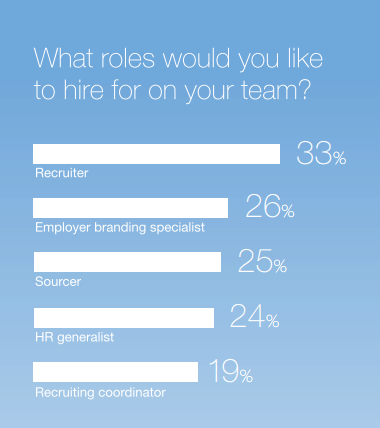40+ employer branding statistics every recruiter should know

Employer branding is one of the strongest hiring trends and it’s definitely here to stay. That said, some companies still underestimate its impact. We’ve aggregated the most important employer branding statistics to give you data you can use as a benchmark to grow your employer brand.
Employer branding statistics
All employer branding statistics presented below come from industry leaders including LinkedIn, SHRM, Harvard Business Review, Glassdoor, Bersin by Deloitte, Edelman Trust Barometer, CareerArc, Jobvite, iCIMS, Melián-González & Bulchand-Gidumal, CareerBuilder and CR Magazine.
Before taking a closer look at the employer branding statistics, let’s answer an important question: why is employer branding important?
According to a LinkedIn study, 75% of candidates report check out the company’s online presence before applying. What is more, companies with a strong employer brand cut their hiring costs by 43%. This proves that an attractive employer brand helps to recruit ideal candidates while lowering the cost.
40+ top employer branding statistics
1. Impact on hiring
80% of talent acquisition managers believe that employer branding has a significant impact on the ability to hire great talent. Source: LinkedIn
2.Salary increase
Online reviews carry major salary increase implications. “Participants shown positive reviews required an average pay increase of between 35-40 percent for a job similar to the one they are doing now. But participants shown neutral reviews of a company required a higher average pay increase (45-50 percent more), while those who saw negative employee reviews required an even higher pay increase (55-60 percent more).” Source: Melián-González & Bulchand-Gidumal via PR Newswire
Source: Melián-González & Bulchand-Gidumal via PR Newswire
3. Turnover costs
Source: LinkedIn
4. Time to Hire & the number of candidates
Source: LinkedIn

Source: LinkedIn
5.Growth rate
Companies with a strong Talent Brand Index on LinkedIn grew 20 % faster than those with a weaker talent brand. Source: LinkedIn
6. Brand awareness
66% of people who changed jobs recently were aware of the existence of the company before hearing about the job opportunity. Source: LinkedIn
7. InMail acceptance rate
Source: LinkedIn
8. InMail response rate
People who follow your company Career Page are 81% likely to answer your InMails that those who don’t. Source: LinkedIn
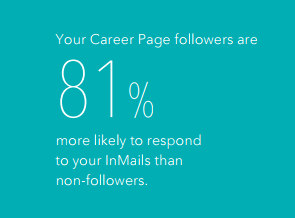 Source: LinkedIn
Source: LinkedIn
9. Using social media for recruitment
Increasing employer brand and recognition comes second on the list of reasons why organizations use social media for recruitment, with 77% survey respondents answering this way (preceded only by recruiting passive candidates with 82%). Source: SHRM
10. How recruitment professionals feel about branding efforts
51% of recruiting professionals plan to increase efforts in branding their employee culture. Source: Jobvite
11. Eagerness to apply
69% of active job seekers believe they are more likely to apply for a position if the employer “actively manages its employer brand”. This includes replying to reviews, updating profiles, sharing updates shedding light on the culture and work environment of that organization. Source: Glassdoor
12. Retention rate
Employer branding affects retention – new hires of companies with a strong employer brand are 40% less likely to leave after the first 6 months. Source: Glassdoor via CareerArc
13. Cost of negative reputation
Source: Harvard Business Review
14. KPIs
“Only 33% of employers track employer branding initiatives to at least one HR performance metric (eg. CPH, retention rate, cost per application, etc.)” Source: CareerArc
15. Culture
Source: Glassdoor
16. Strategy
Only 57% of employers report having an employer brand strategy. Source: CareerArc
17. Tools
49% of employers believe they don’t have the tools to effectively enhance the employer brand. Source: CareerArc
18. Factors influencing a candidate’s impression of a job
Online research is the second biggest factor influencing a candidate’s impression of a job. Source: Jobvite
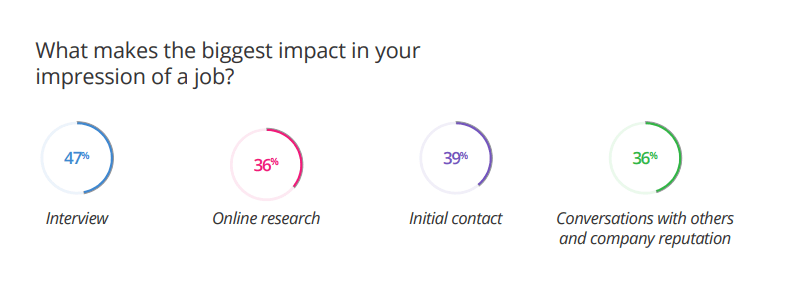 Source: Jobvite
Source: Jobvite
19. Who manages employer brand
In 36% of companies, recruiting collaborates with marketing/communications to manage employer brand. Source: LinkedIn
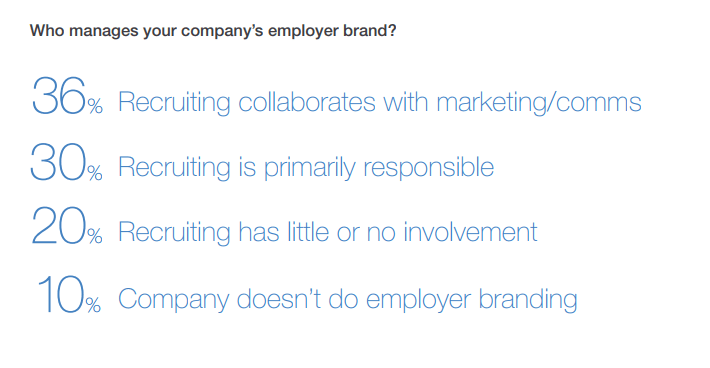
Source: LinkedIn
20. How many people manage your employer brand
In most companies, employer brand is managed by 1-5 people (52%) and in 9% of companies this role is not assigned to anyone. Source: LinkedIn
 Source: LinkedIn
Source: LinkedIn
21. Channels to build an employer brand
A career site is the best channel for building an employer brand (61%) and traffic to this site is the best way to measure your employer site (36%). Source: LinkedIn
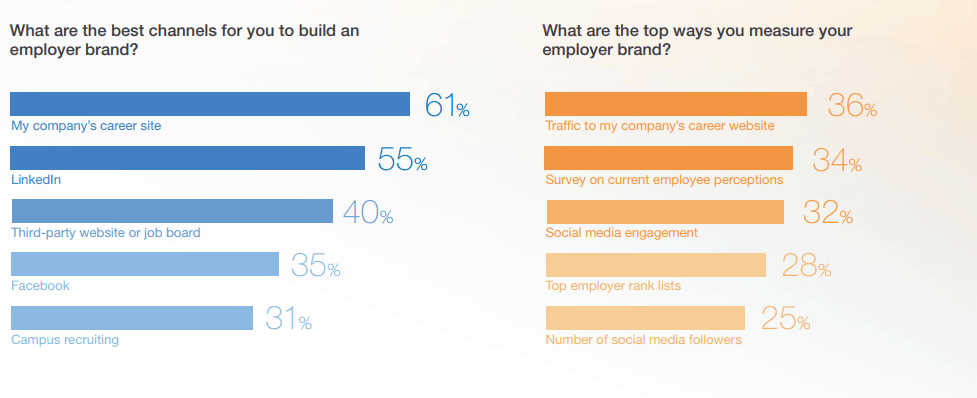
Source: LinkedIn
22. EB specialists
Source: LinkedIn
Source: LinkedIn
23. Unlimited budgets
If they had unlimited budgets, companies would like to invest in employer branding most (53%). Source: LinkedIn
24. Forming an opinion
Source: Glassdoor
25. Biggest roadblock to changing jobs
Not knowing what it’s like to work for a company is the #1 roadblock to changing jobs. Source: LinkedIn
26. How bad reputation affects hiring
Source: CR Magazine
27. Bad reputation vs. unemployment
Source: CR Magazine
28. What damages your employer brand most
Negative reviews of products & services are the #1 factor damaging employer brand (rated as “damaging” by 95% of workers and “very damaging” or “extremely damaging” by 80% of workers). Source: CareerArc
 Source: CareerArc
Source: CareerArc
29. How job seekers evaluate employer brand
62% of job seekers use social media channels to evaluate the employer brand of a company. Source: CareerArc
30. Why employer branding matters
75% of job seekers take employer branding into consideration before applying for a job with a company. Source: CareerArc
31. Company reviews and ratings
61% of Glassdoor users say they look for “company reviews and ratings before making a decision to apply for a job.” Source: Glassdoor
32. Impact on changing jobs
92% of people would consider changing jobs if offered a role with a company with an excellent corporate reputation. Source: CR Magazine
33. Employee treatment
Employee treatment is the #1 category important in evaluating employer brand (for both employers and employees).Honesty and transparency came second in the survey. Source: CareerArc
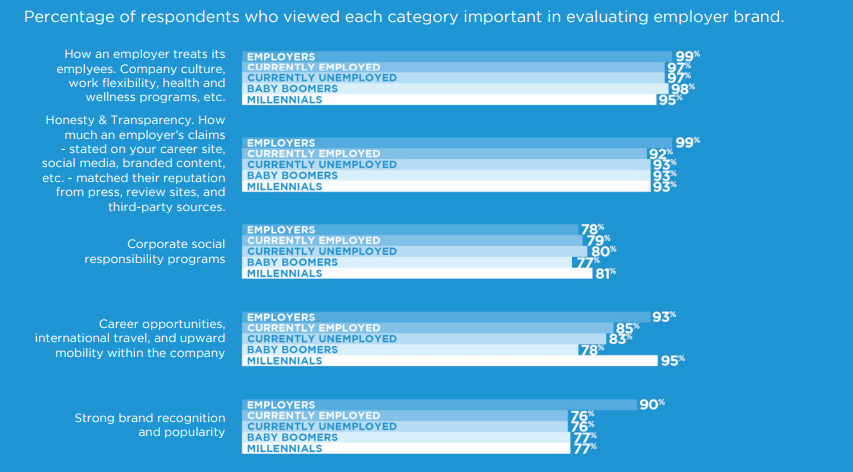 Source: CareerArc
Source: CareerArc
34. What candidates are interested in
While 66% of candidates are interested in your company culture, 54% and 50% are interested in perks available and mission, respectively. Source: LinkedIn
35. Interest in daily activities
Source: CareerBuilder
36. How responding to reviews affects your employer branding
“62% of Glassdoor users agree their perception of a company improves after seeing an employer respond to a review.” Source: Glassdoor
Source: Glassdoor
37. Why updating your candidates about their status matters
72% of employees report not being notified of the status of your application or decision made leads to a negative impression of that employer. Source: CareerArc
 Source: CareerArc
Source: CareerArc
38. How candidates get a sense of your culture
Social media channels serve as a “window into company culture”, with Facebook being used by 21% of candidates who want to get a sense of company culture based on browsing photos and content on the site. Source: Jobvite
39. Recruitment vs. marketing
Source: iCIMS
40. Employee voice
Employee voice is 3x more credible than the CEO’s when it comes to talking about working condition in that company. Source: Edelman Trust Barometer
Source: Edelman Trust Barometer via LinkedIn
41. Which brands are more trustworthy
“75% of U.S. respondents believe that companies whose C-Suite executives and leadership team use social media to communicate about their core mission, brand values, and purpose are more trustworthy.” Source: The Global Social CEO Survey, Brandfog via Glassdoor
42. What Millennials value at work
For Millennials, the “ability to learn and progress” is the principal driver of the employment brand of an organization. Source: Bersin by Deloitte proprietary research with Glassdoor
Employer branding statistics – conclusion
Curious to know how you can turn these results into action in tech?
Check out our free Tech Recruitment Certification Course!
Share post

